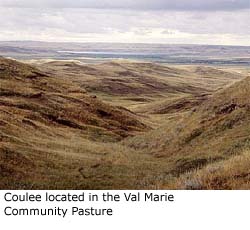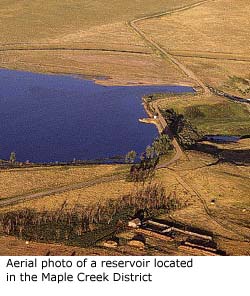COMMUNITY WATER DEVELOPMENT PROJECTS

Many community projects were built to develop the water resources of secondary tributaries,
where
the works were confined to a municipality or county and were designed to serve the agricultural
needs of
the inhabitants of that particular rural area.
The terms of reference for types and sizes of community projects were broad.
Many projects involved the restoration and improvement of natural bodies of water that tended to
dry up
during droughts. By installing control works and sometimes diverting additional drainage into
them,
these natural reservoirs could be restored and held at former levels.
Streams, coulees or ravines that yield a reasonable amount of runoff often make good sites for
damming
and impounding surplus water. Where there are no natural channels or depressions of any kind,
large
dugouts may be excavated. Those now in use generally have a capacity of a million gallons of
water or
more.
The water resources in most of the smaller streams and rivers of the prairies have been
harnessed
at some point or other by the construction of such projects. The dependable water supplies they
provide have made it possible for some prairie towns and rural municipalities to develop modern
water-supply facilities for domestic and industrial purposes.
Some of the earliest work of this type was done in the drylands of southwest Saskatchewan and
the
special Areas of east-central Alberta.
Generally, community projects were handled through a cooperative arrangement with the
provincial
government and the local communities involved. A local agricultural district or community
organization
made an application through the province for such a project, agreeing to supply the land required
for
the scheme and to maintain and operate the project after completion. After the provincial
government
had cleared the plan, both from an agricultural and water rights standpoint, they formally
requested that
Prairie Farm Rehabilitation Administration (PFRA) to supply the engineering services that would
be
required and to contribute toward the cost of construction. Since the water development program
began in 1935, more
than 1,000 of these community projects have been developed on the prairies, with a view to
achieve a
greater degree of stability in prairie agriculture. Of particular significance has been the benefit to
the
livestock industry, through the creation or improvement of water facilities on farms, pasture and
feedlots, and through the production of reserve supplies of forage grown under irrigation for the
winter
maintenance of livestock

Decades later, hundreds of these reservoirs dot the prairies. Although most of them were built to
store
water for stockwatering or irrigation, they could be used to supply nearby towns and villages as
well. Many prairie communities continue to take their water supplies from reservoirs built by
PFRA.
The most ambitious program of water development at the community level occurred under the
federal-provincial Agricultural Service Centres Agreements. Beginning in 1972, $54 million was
provided to build new water and sewage works in 49 towns and cities in Alberta, Saskatchewan
and
Manitoba. This included a wide variety of structures: reservoirs, wells, pumphouses, water and
sewer
mains and treatment plants.
Although the Agricultural Service Centres Agreements expired in all three Prairie Provinces by
1983,
other arrangement have been ongoing to continue federal-provincial cooperation in this type of
work.

